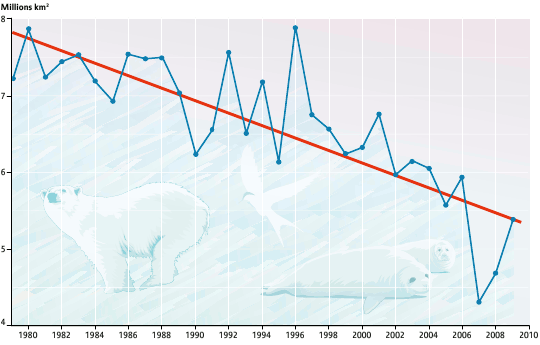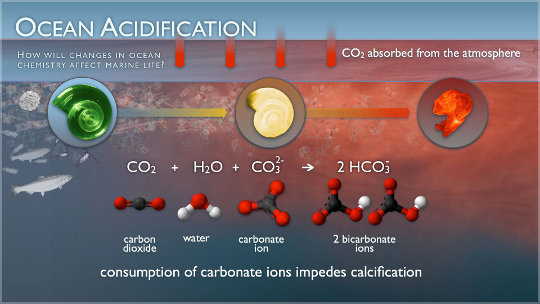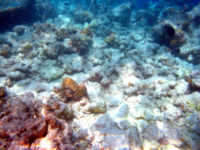The link between climate change and biodiversity has long been established. Although throughout Earth’s history the climate has always changed with ecosystems and species coming and going, rapid climate change affects ecosystems and species ability to adapt and so biodiversity loss increases.
From a human perspective, the rapid climate change and accelerating biodiversity loss risks human security (e.g. a major change in the food chain upon which we depend, water sources may change, recede or disappear, medicines and other resources we rely on may be harder to obtain as the plants and forna they are derived from may reduce or disappear, etc.).
The UN’s Global Biodiversity Outlook 3, in May 2010, summarized some concerns that climate change will have on ecosystems:
Climate change is already having an impact on biodiversity, and is projected to become a progressively more significant threat in the coming decades. Loss of Arctic sea ice threatens biodiversity across an entire biome and beyond. The related pressure of ocean acidification, resulting from higher concentrations of carbon dioxide in the atmosphere, is also already being observed.
Ecosystems are already showing negative impacts under current levels of climate change … which is modest compared to future projected changes…. In addition to warming temperatures, more frequent extreme weather events and changing patterns of rainfall and drought can be expected to have significant impacts on biodiversity.
Some species may benefit from climate change (including, from a human perspective, an increases in diseases and pests) but the rapid nature of the change suggests that most species will not find it as beneficial as most will not be able to adapt.
On this page:
Climate change impacts on biodiversity in the Arctic
The Arctic, Antarctic and high latitudes have had the highest rates of warming, and this trend is projected to continue, as the above-mentioned Global Biodiversity Outlook 3 notes (p. 56).
In the Arctic, it is not just a reduction in the extent of sea ice, but its thickness and age. Less ice means less reflective surface meaning more rapid melting. The rapid reduction exceeds even scientific forecasts and is discussed further on this site’s climate change introduction.

In terms of biodiversity, the prospect of ice-free summers in the Arctic Ocean implies the loss of an entire biome
, the Global Biodiversity Outlook notes (p. 57).
In addition, Whole species assemblages are adapted to life on top of or under ice — from the algae that grow on the underside of multi-year ice, forming up to 25% of the Arctic Ocean’s primary production, to the invertebrates, birds, fish and marine mammals further up the food chain.
The iconic polar bear at the top of that food chain is therefore not the only species at risk even though it may get more media attention.
Note, the ice in the Arctic does thaw and refreeze each year, but it is that pattern which has changed a lot in recent years as shown by this graph:

It is also important to note that loss of sea ice has implications on biodiversity beyond the Arctic, as the Global Biodiversity Outlook report also summarizes:
- Bright white ice reflects sunlight.
- When it is replaced by darker water, the ocean and the air heat much faster, a feedback that accelerates ice melt and heating of surface air inland, with resultant loss of tundra.
- Less sea ice leads to changes in seawater temperature and salinity, leading to changes in primary productivity and species composition of plankton and fish, as well as large-scale changes in ocean circulation, affecting biodiversity well beyond the Arctic.
(This site’s intro to climate change and Arctic geopolitics has more about the impact to the Arctic.)
Increasing ocean acidification

Although it has gained less mainstream media attention, the effects of increasing greenhouse emissions — in particular carbon dioxide — on the oceans may well be significant.
Scientists have found that oceans are able to absorb some of the excess CO2 released by human activity. This has helped keep the planet cooler than it otherwise could have been had these gases remained in the atmosphere.
However, the additional excess CO2 being absorbed is also resulting in the acidification of the oceans: When CO2 reacts with water it produces a weak acid called carbonic acid, changing the sea water chemistry. As the Global Biodiversity Outlook report explains, the water is some 30% more acidic than pre-industrial times, depleting carbonate ions — the building blocks for many marine organisms.
In addition, concentrations of carbonate ions are now lower than at any time during the last 800,000 years. The impacts on ocean biological diversity and ecosystem functioning will likely be severe, though the precise timing and distribution of these impacts are uncertain.
(See p. 58 of the report.)
Although millions of years ago CO2 levels were higher, today’s change is occurring rapidly, giving many marine organisms too little time to adapt. Some marine creatures are growing thinner shells or skeletons, for example. Some of these creatures play a crucial role in the food chain, and in ecosystem biodiversity.
Some species may benefit from the extra carbon dioxide, and a few years ago scientists and organizations, such as the European Project on OCean Acidification, formed to try to understand and assess the impacts further.
One example of recent findings is a tiny sand grain-sized plankton responsible for the sequestration of 25–50% of the carbon the oceans absorb is affected by increasing ocean acidification. This tiny plankton plays a major role in keeping atmospheric carbon dioxide (CO2) concentrations at much lower levels than they would be otherwise so large effects on them could be quite serious.
Other related problems reported by the Inter Press Service include more oceanic dead zones (areas where there is too little oxygen in the sea to support life) and the decline of important coastal plants and forests, such as mangrove forests that play an important role in carbon absorption. This is on top of the already declining ocean biodiversity that has been happening for a few decades, now.
There is also a linkage with climate change:
Ocean stratification, where warm water sits firmly on top of cold, nutrient-rich water, also creates dead zones and lowers the overall productivity of the oceans.… Such dead zones were rare 40 years ago but now number several hundred. Without urgent action, climate change will continue to warm oceans, increasing stratification and producing larger and more dead zones with a major impact on future fisheries, a 2009 study in Nature Geoscience warned.
It will take a thousand years for the oceans to cool down, so it is imperative to pull the emergency brake on global warming emissions, the study concluded.
Coral reefs threatened by climate change
Around the world, coral reefs have been dying largely due to climate change.


Healthy coral is very colorful and rich with marine life.
At the beginning of September, 2009, the Australian agency looking after the Great Barrier Reef released an outlook report warning the Great Barrier Reef is in trouble.
But it is not just the Great Barrier Reef at risk. All of them are at risk, says Charlie Veron, an Australian marine biologist who is widely regarded as the world’s foremost expert on coral reefs.
The future is horrific
, he says. There is no hope of reefs surviving to even mid-century in any form that we now recognize. If, and when, they go, they will take with them about one-third of the world’s marine biodiversity. Then there is a domino effect, as reefs fail so will other ecosystems. This is the path of a mass extinction event, when most life, especially tropical marine life, goes extinct.
Coral reefs provide many ecosystem services to humans as well, for free. This site’s page on coral reefs goes into these issues in more depth.
Lizards threatened by climate change

What the BBC described as a global-scale study
published in the journal Science found that climate change could wipe out 20% of the world’s lizard species by 2080.
Global projection models used by the scientists suggested that lizards have already crossed a threshold for extinctions caused by climate change
.
The fear of lowland species moving to higher elevations has long been predicted as an effect of climate change. This has been observed with lizard populations too, as the leader of the research team told the BBC: We are actually seeing lowland species moving upward in elevation, slowly driving upland species extinct, and if the upland species can’t evolve fast enough then they’re going to continue to go extinct.
Why are lizards so sensitive to climate change? The BBC summarizes:
Lizards, the researchers say, are far more susceptible to climate-warming extinction than previously thought. Many species live right at the edge of their
thermal limits.Rising temperatures, they explained, leave lizards unable to spend sufficient time foraging for food, as they have to rest and regulate their body temperature.
Other examples
The above areas of biodiversity affected is by no means exhaustive. Other areas affected by climate change include terrestrial animals, and forests, water sources and related ecologies, and so on. For more information on those areas, see this site’s sections on

